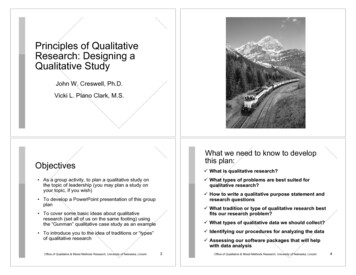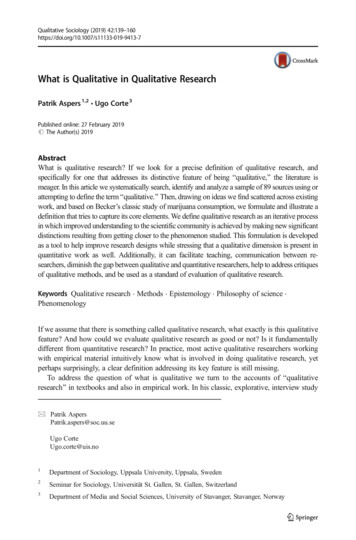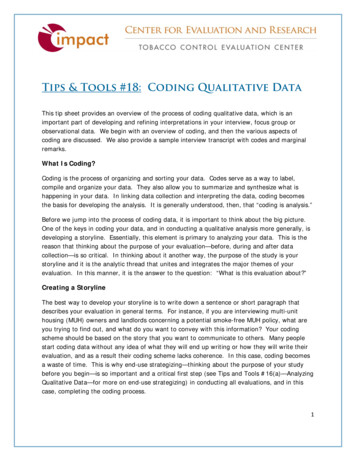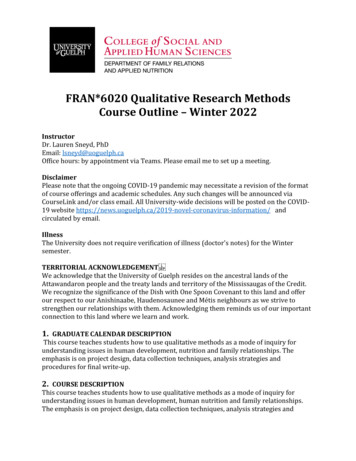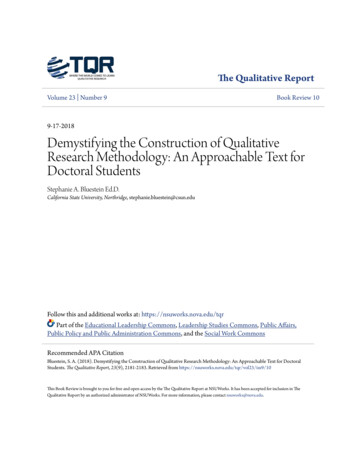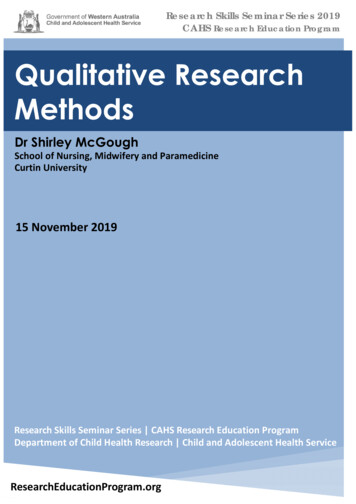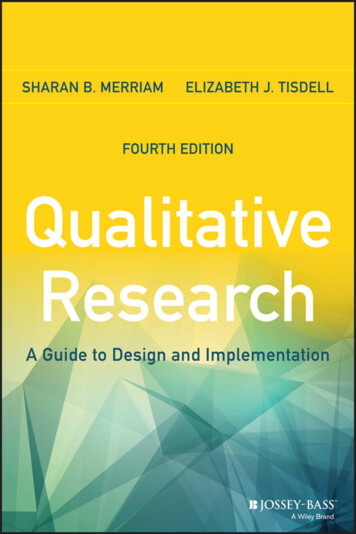
Transcription
Raj et al. BMC Public Health(2019) ARCH ARTICLEOpen AccessStudents and brides: a qualitative analysisof the relationship between girls’ educationand early marriage in Ethiopia and IndiaAnita Raj1,2*, Marissa Salazar3, Emma C. Jackson4, Natalie Wyss2, Katherine A. McClendon5, Aarushi Khanna6,Yemeserach Belayneh7 and Lotus McDougal2AbstractBackground: Early marriage ( 18 years) is associated with education cessation among girls. Little research hasqualitatively assessed how girls build resiliency in affected contexts. This study examines these issues in Oromia,Ethiopia and Jharkhand, India among girls and their decision-makers exposed to early marriage prevention programs.Methods: Qualitative interviews were conducted with girls who received the intervention programs and subsequentlyeither a) married prior to age 18 or b) cancelled/postponed their proposed early marriage. Girls also selected up tothree marital decision-makers for inclusion in the study. Participants (N 207) were asked about the value and enablersof, and barriers to, girls’ education and the interplay of these themes with marriage, as part of a larger in-depthinterview on early marriage. Interviews were transcribed, coded, and analyzed using latent content analysis.Results: Participants recognized the benefits of girls’ education, including increased self-efficacy and life skills for girlsand opportunity for economic development. A girl’s capacity and desire for education, as well as her self-efficacy todemand it, were key psychological assets supporting school retention. Social support from parents and teachers wasalso important, as was social support from in-laws and husbands to continue school subsequent to marriage. Postmarriage education was nonetheless viewed as difficult, particularly subsequent to childbirth. Other noted barriers togirls’ education included social norms against girls’ education and for early marriage, financial barriers, and poor valueof education.Conclusion: Social norms of early marriage, financial burden of school fees, and minimal opportunity for girls beyondmarriage affect girls’ education. Nonetheless, some girls manifest psychological resiliency in these settings and, withsupport from parents and teachers, are able to stay in school and delay marriage. Unfortunately, girls less academicallyinclined, and those who do marry early, are less supported by family and existing programs to remain in school;programmatic efforts should be expanded to include educational support for married and childbearing girls as well asoptions for women and girls beyond marriage.Keywords: Early marriage, education, adolescent health, gender roles, Ethiopia, India* Correspondence: anitaraj@ucsd.edu; artment of Education Studies, Division of Social Sciences, University ofCalifornia San Diego, 9500 Gilman Drive, La Jolla, CA 92093, USA2Center on Gender Equity and Health, Department of Medicine, University ofCalifornia San Diego, 9500 Gilman Drive, La Jolla, CA 92093, USAFull list of author information is available at the end of the article The Author(s). 2019 Open Access This article is distributed under the terms of the Creative Commons Attribution 4.0International License (http://creativecommons.org/licenses/by/4.0/), which permits unrestricted use, distribution, andreproduction in any medium, provided you give appropriate credit to the original author(s) and the source, provide a link tothe Creative Commons license, and indicate if changes were made. The Creative Commons Public Domain Dedication o/1.0/) applies to the data made available in this article, unless otherwise stated.
Raj et al. BMC Public Health(2019) 19:19BackgroundEarly marriage, defined as marriage before the age of18, is a pervasive health and human rights issue thatdisproportionately affects women and girls [1]. Globally, 15 million girls are married by age 18 each year;by the year 2030, 950 million girls will have been married as children [1]. Early marriage is associated withserious adverse health and social outcomes, includingcompromised sexual, reproductive, and maternal health,increased risk of depression and suicidality [2–9], greaterrisk of intimate partner violence [4–8], decreased social and physical mobility, and decreased autonomy indecision-making within and outside of the household[10, 11]. Early marriage also compromises girls’ abilityto attend school post-marriage, exposing them to anarray of adverse social and health outcomes associatedwith education cessation [10–17].Though early marriage is declining globally, prevalenceremains highest in Sub-Saharan Africa and South Asia[1]. In India, 27% of 20–24 year old females are marriedby age 18, and 7% are married by age 15 [18]. InEthiopia, 40% of 20–24 year old females are married byage 18, and 14% are married by age 15 [19]. Over thelast ten years, early marriage has declined by 19% inIndia and by 9% in Ethiopia [18, 19]. While this progressis commendable, the rate of progress is inadequate whenmore than one in four girls in India and two in five girlsin Ethiopia may be subject to this harmful practice andits deleterious social and health effects.Research has identified that promotion of girls’ education is a key means of reducing early marriage in manycontexts [20–22]. While girls not in school may be morevulnerable to early marriage, early marriage itself mayserve as a barrier to post-marriage school attendancedue to early childbirth and related child-care responsibilities [12], and/or restriction of school attendance bygirls’ husband or in-laws [17, 23]. Hence, the associationbetween education and early marriage is likely bidirectional[10, 16, 22, 24–27]. Reduced economic self-sufficiency as aresult of education cessation and subsequent early marriageis also of particular concern in contexts where the burden ofearly marriage is highest [1, 10, 11, 13, 14, 16, 22, 28–34].School cessation limits economic empowerment, specificallyin the ability to earn an independent income, which is oftenfurther constrained within the context of early marriage[10, 11, 14]. On the other hand, educational attainmentincreases economic self-sufficiency among women andgirls, and is associated with less reliance on male partners,as well as increased self-efficacy [20, 32, 35, 36]. The consequences of education cessation are similar to that of earlymarriage and include reduced access to sexual and reproductive health education and services, social isolation frompeers and mentors, and decreased social mobility underscored by economic vulnerability [11, 22, 34, 37, 38].Page 2 of 20Given the well-documented association between education cessation and early marriage, many programmaticefforts now focus on keeping girls in school in an effortto reduce early marriage [20, 22, 39]. Several programsaimed to increase girls’ school attendance have alsoshown decreases in early marriage [40–43]. However, investigation of this relationship has been primarily quantitative in nature; little work has examined how girls andcommunities perceive the costs and benefits of girls’education relative to early marriage and what normsreinforce these perceptions [10, 22, 44]. The pathwaysconnecting girls’ education and delayed marriage arerooted in social norms and values related to girls andgender equality, therefore a deeper understanding of thisinterplay is needed to comprehensively address these issues [8].One lens through which we can understand how adolescents can challenge these norms is that of ResiliencyTheory, which takes a strength-based approach to positthat youth facing serious stressors and barriers are ableto overcome obstacles and succeed with assets or resources available at the contextual, social or individuallevel [45]. Such assets and resources can include community programs and family support for education, aswell as self-efficacy and aspiration at the individual levelof the girl. Through this study, we sought to gain insightinto obstacles and resilience related to the relationshipbetween girls’ education and early marriage in Oromia,Ethiopia and Jharkhand, India, where the practice ofearly marriage remains common [18, 19]. This study includes data from both girls and their key maritaldecision-makers, as girls in these contexts are often unable to decide unilaterally when and whom to marry.MethodsStudy settingThis study uses data collected in Oromia, Ethiopia andJharkhand, India. Oromia has a population of 27 millionpeople, 88% of whom live in rural areas [46]. Educationalattainment is low; more than half of women (51%) havehad no formal education, and only 12% have secondary orhigher education [19]. Amongst women aged 15–49 yearsold, 33% were employed in the past 12 months, comparedto 92% of male counterparts [19]. The median age of marriage among 20–24 year olds was 18.2 [19, 47]. Similarly,the Indian state of Jharkhand has a population just under33 million, with 76% residing in rural areas [48]. Educational attainment in Jharkhand is also low; 37% of womenhave no formal education, though more than half (52%)have secondary or higher education [18, 47]. Thirty-twopercent of women aged 15–49 years old were employed inthe last 12 months, compared to 97% of male counterparts, and the median age at first marriage among 20–24year old females was 19.0 [18].
Raj et al. BMC Public Health(2019) 19:19Study design and sampleData from the current study were collected as part of a larger program aimed at reducing early marriage and improving reproductive and sexual health among adolescent girls.While implementation of the program differed slightly,program aims were consistent. The Oromia DevelopmentAssociation Comprehensive Adolescent/Youth Sexual andReproductive Health Project (“ODA”) is a school-basedprogram which began in 1993 in Oromia, Ethiopia. ODA isimplemented by teachers and operates both within schoolsand through community outreach. Project RISHTA, firstimplemented in 2001 in Jharkhand, India, is acommunity-based program delivered by trained youthleaders. Both programs incorporate instruction on adolescent marriage, the health effects of early pregnancy andchildbirth, family planning and contraception, and vocational training.In 2014, research staff conducted qualitative interviewswith program participants aged 13–24 years and up tothree of their marital decision makers to investigate theunderlying structures that lead to delayed early marriage,specifically the complexities of marital decision-making.To be eligible for an interview, participants had to be female ODA/Project RISHTA participants who either: a)married prior to the age of 18 (“girl married 18”), or b)were able to cancel/postpone marriage until age 18 orlater (“girl able to cancel/postpone marriage”). Interviewedgirls were also asked to identify up to three marital decision makers to participate in the study. Participants inEthiopia were recruited in two of the eight “woredas” (districts) that originally implemented the ODA project,resulting in a sampling frame of 124 primary schools inOromia. Teachers, community health workers, and program staff identified potential participants, and interviewers subsequently recruited participants directly fromtheir homes. Similar recruitment methods were used inIndia; a sampling frame of 32 villages within the SaraikelaKharsawan district of Jharkhand were identified, a list ofall eligible participants was created, and interviewers wentto women and girls’ homes to invite them to participate.In the Indian sample, preference was given to women andgirls whose marriages or proposals were most recent.ProcedureTrained research staff conducted semi-structured, audiorecorded interviews lasting approximately 45 minuteswith ODA/Project RISHTA participants (N 104) andup to three of their marital decision makers (N 161).In Ethiopia, 23 women and girls married 18 and 42 oftheir marital decision makers were interviewed, as wellas 27 women and girls able to cancel/postpone marriage 18 and 59 of their marital decision makers. InIndia, 25 women and girls married 18 and 29 of theirmarital decision makers were interviewed. Additionally,Page 3 of 2029 women and girls able to cancel/postpone marriage 18 and 31 of their marital decision makers were interviewed. Further details on study procedures are discussed elsewhere [49–51].Interviews were de-identified, transcribed and translated into English. Following translation, we excluded 58interviews from analyses due to poor interview qualityor failure to meet eligibility requirements (e.g., duplicateinterviews, and unmatched decision-maker participants).Excluded interviews were primarily (78%) from Ethiopia,though final samples were comparable across groups.Our final analytic sample of n 207 included: 21 girls with canceled/delayed early marriages inEthiopia and 41 of their marital decision-makers 23 girls married as minors in Ethiopia and 21 oftheir marital decision-makers 24 girls with canceled/delayed early marriages inIndia and 27 of their marital decision-makers 25 girls married as minors in India along with 25 oftheir marital decision-makers.Interview QuestionsThe in-depth interviews aimed to understand participants’perceptions of ODA and Project RISHTA, and their viewson early marriage and education (see Additional file 1).Questions related to education assessed participants’ attitudes towards education, their perceptions of the benefitsand disadvantages of education, gender norms related togirls’ education, and educational attainment post marriageand post childbirth. Sample questions included: “Up towhat level should a girl continue her education before getting married?” “What do you think about girls’ education?”and “Do you think girls should go to school like boys do?”Data AnalysisTwo PhD level social science and public health researchers oversaw all data analysis for this study, and, inpartnership with three trained research assistants, reviewed20% of all interviews by type of interviewee. A latent content analysis was used to develop a coding structure withthemes and sub-themes under a series of domains corresponding with content foci of interview questions (e.g.,early marriage, marital choice and decision-making, education) [52, 53]. A final coding scheme was created based onemergent theme identification and coder agreement. Seventrained research assistants coded and analyzed all datausing Atlas.ti. Inter-coder reliability was assessed usingCohen’s kappa 0.9.Current analyses focus on findings related to education, which generated the following themes: perceivedbenefits and disadvantages of girls’ education; enablersand barriers to girls’ continuation of secondary education; enablers and barriers to girls’ continuation of
Raj et al. BMC Public Health(2019) 19:19Page 4 of 20secondary education subsequent to marriage. Subthemesand sub-subthemes were developed from these themes,providing a hierarchical analysis of themes constructedinto dendritic trees. Further detail on our coding processcan be found in our previous publications [49–51].Using resiliency theory as our framework, we againreviewed themes and subthemes to reflect on enablerssupporting girls’ education, and to profile social and cognitive assets and resources more directly [45].develop and self-actualize their own goals, and managetheir lives.“If [a girl is] not educated, she may not be able toidentify what will help or harm her. She has noawareness about the socioeconomic benefits [ofeducation]. [If a girl is not educated,] it makes herthink that she is less than boys.” [Girl able to cancel/postpone marriage, Student, age 13–17, Ethiopia]Results“The future for girls who are educated is brighter becausethey have more knowledge. The girls who are noteducated only know what they see on television or whatothers tell them.” [Female decision-maker for girl ableto cancel/postpone marriage, Tata Steel FamilyInitiative Foundation, Sarna, age 35–49, India]Participant CharacteristicsParticipants (N 207) from the current study ranged inmedian age from 14 to 19 years among girls, and 26–39 years among decision-makers (Table 1). The relationship between decision-makers and girls varied bycountry and marital status. Among girls in Ethiopiawhose marriages were postponed/cancelled, the majorityof decision-makers were participants’ teachers, followedby father, mother, and other relatives (e.g., siblings, aunts/uncles, and grandparents), whereas decision makers ofmarried participants were generally their parents. In India,decision makers of girls whose marriages were postponed/cancelled were primarily their parents, RISTHA staff, andother relatives, whereas decision makers of married participants were mostly their husbands, mothers, fathers andother relatives.“The educated girls make their own future. Theuneducated are like “bandhi hui gai” (like a cow tied toa pole) who is dependent on in-laws and her husband.”[Girl married 18, Student, Sarna, age 18–24, India]Additionally, participants in Ethiopia emphasized thevalue of education and safety to pursue education as human rights, and the role of education in helping girlsrecognize their human rights.THEME 1. Benefits and Disadvantages of Girls’ EducationBenefits of Girls’ Education In both Ethiopia andIndia, participants had primarily positive views regardinggirls’ educational attainment, and participants reportedbenefits directly for girls and the families and childrenthey may have, as well as benefits for the larger community and society (Fig. 1). Benefits directly related to girlsincluded improved life skills, domestic capacities relatedto both household management and childrearing, andeconomic capacities including financial management ofhouseholds and potential career development. Thesebenefits were recognized as bringing value to the familyand the community as a whole.Education Increases Girls’ Self-Efficacy. Participants inboth India and Ethiopia noted the value of education interms of supporting girls to have increased perceivedand actual self-efficacy to be able to value themselves,“Students know the basic human and democraticrights. In previous regimes, girls were not decidingtheir rights but now they have right to decide. Now,she has learned everything about the constitution andrights. With coordination of school administrationand the community, efforts are underway to respecther rights.” [Male decision maker for girl able tocancel/postpone marriage, Teacher, Protestant, age18–24, Ethiopia]“They (girls) have equal rights with boys to continuetheir education. The problem is with the community.There are only 44 students enrolled in our school thisyear while there are a lot of girls in the community.The society doesn’t want to send their girls to school.”[Male, decision maker for girl able to cancel/Table 1 Demographic summary of participants (n 207)EthiopiaIndiaMarried 18GirlCancelled/postponed marriageMarried erCancelled/postponed marriageGirlDecision-makerTotal n(%)23 (21.7%)21 (19.8%)21 (19.8%)41 (38.7%)25 (24.8%)25 (24.8%)24 (23.8%)27 (26.7%)Median age (IQR)18 (16–18)38 (30–45)14 (14–15.5)26 (24–30)18 (18–20)27 (23–41)19 (18–20.25)39 (32.5–45)
Raj et al. BMC Public Health(2019) 19:19Page 5 of 20Fig. 1 Benefits and Disadvantages of Girls Education: Note: Blue indicates findings reflect Ethiopia and India. Purple indicates findings only reflectEthiopia. Red indicates findings only reflect Indiapostpone marriage, Teacher, Orthodox, age 25–34,Ethiopia]numbers.” [Male decision maker for girl able tocancel/postpone marriage, Health Worker, Hindu,age 25–34, India]“When I was attending the lower class, meaningfrom grade 1-3, everybody was abusing us on ourway to and from school. But recently, after genderequality has been ensured and women’s right haslegally been protected, I recognized that we haveequal rights. So, no one can abuse me like that.There is also a time when we legally defendedourselves from those abusive men. There is also atime I told my parent and defended myself.” [Girlable to cancel/postpone marriage, Student,Muslim, age 13–17, Ethiopia]The value of literacy was also tied to marital prospects.Education Increases Literacy, Supporting Girls’ LifeSkills. Decision-makers also noted the importance of literacy gained in schools in allowing girls to participate inand navigate life more effectively and less vulnerably.If [girls] don’t learn, they are going to be illiterate likewe are. [Female decision maker for girl married 18, Farmer, Muslim, age 35-49, Ethiopia]“ Even for travelling, [an education is needed to dothings like] reading the road signs and the bus“The literate girls are more appreciated by peopleand they get good marriage proposals. They aremore intelligent and street-smart. The illiterate girlsare very gullible.” [Female decision maker for girlmarried 18, Housewife, Sarna, age 25–34,India]Education Increases Girls’ Domestic Capacities –Household Management and Childrearing. Related to lifeskills, but more gendered in nature, participants described education as increasing girls’ domestic capacitiesfor family life, both in terms of managing a householdand being a good mother. These concepts were noted inboth countries, but more often in India.“[An educated girl] can give proper upbringing andeducation to her child since males don’t stay athome and educate the children, who are the futureof the family, community & village. [Educating thechildren] is the sole responsibility of thefemale.”[Girl married 18, Student, Hindu, age18–24, India]
Raj et al. BMC Public Health(2019) 19:19“Yes, it is important to educate girls the way boys areeducated, as it makes the brain sharper and can behelpful in so many ways, including managing a family,educating one’s own children, managing householdaffairs, and even earning [money]” [Girl married 18,Housewife, Sarna, age 18–24, India]“In education, one who cannot learn cannot changeoneself, can keep her house clean, can agree with theirpartner. So, if marriage delays, the girls can get achance of completing their education and can get thoseadvantages.” [Male decision maker for girl able tocancel/postpone marriage, Civil Servant, Muslim,age 25–34, Ethiopia]Participants in India further noted that this increaseddomestic capacity could reduce risk of conflict with husbands and in-laws.“It is good to educate girls like the boys [are educated]. Ifa girl is educated, she will be able to manage her houseand family well and chances of conflicts with husbandand in-laws will reduce substantially. [An educated girl]understands issues like the importance of a small familywith one or two children, she is in a better position toeducate her child, and can even earn a good amount [ofmoney] by working.”[Female decision maker for girlmarried 18, SHG/Peer Educator with ProjectRISHTA, Sarna, age 25–49, India]Conversely, girls denied education due to early marriage recognized the loss, and worried about how itcompromised their ability to support their children’seducational development.“Yes, it is important for the girls to go to school likeboys do. I am not educated and I feel restricted inmany things. Like I cannot read and write, and nowthat my son is growing, I won’t be able to teach himeither. I will be completely dependent on the school [toteach him].” [Girl married 18, Housewife, Sarna,age 18–24, India]Education Increases Girls’ Economic Capacities –Household Financial Management and Career Aspirations and Opportunities. In Ethiopia, though not India,participants described how girls’ education could increase financial management skills in ways that could beapplied to the household and could help ensure husbands did not misuse household funds.“Upon getting [an] education, girls learn how to keeptheir child, themselves, and their homes clean. Yes,Page 6 of 20girls must learn, since it helps them with homemanagement. We can get knowledge on how to savemoney and wash home tools.” [Girl married 18,Housewife, Muslim, age 18–24, Ethiopia]“In terms of economy, [an educated woman] will workwith her husband because she has a good experience.If he tries to spend their wealth, she will force him tosave. Since she has experiences [with education] shewill advise him on how to raise their children, how tomake a living, and how to save money.” [Girl able tocancel/postpone marriage, Student, Muslim, age13–17, Ethiopia]Discussion in both India and Ethiopia touched on girls’education as a driver of girls’ career aspirations and opportunities. However, in India girls discussed careers oriented in traditionally female roles (e.g., teacher, cook,embroidery work), recognizing that some careers requiremore education than others.“I would like to study until class 8 or class 10. [When Iam done with school,] I would like to do embroiderywork and stitching etc.” [Girl able to cancel/postpone marriage, Muslim, age 18–24, India]“I want to do BA, MA and then become a teacher. I lovestudying and teaching.” [Girl able to cancel/postponemarriage, Student, Hindu, age 13–17, India]Participants from India described female employmentas benefitting the family as a whole, and as protectionfor girls who do not marry.“If a girl is educated, the entire family is educated. Shecan go for a well-paid job and is in a better conditionto bear the expenditures of a family. The family [of aneducated girl] is more mature and financially betteroff.” [Girl able to cancel/postpone marriage,Student, Hindu, age 18–24, India]At the same time, some recognized that they may haveto contend with family or in-laws’ attempts to impedetheir career aspirations, despite these recognized benefits. However, they felt able to achieve their goals despiteany resistance from family.“I would like to complete my education, do B. A. andthen I want to become a teacher. There may be someproblems and the in- laws may not allow [me to dothis], but if one wants [to do something] nobody canstop [them].” [Girl able to cancel/postpone
Raj et al. BMC Public Health(2019) 19:19marriage, Student and Housewife, Hindu, age 18–24, India]In contrast, participants in Ethiopia discussed more diverse careers for girls that were not limited to predominantly female occupations, and even described careeropportunity as a means for girls’ independence and control over decisions regarding their life course. Employment was tied to increased agency and freedom, asopposed to viewing employment solely as a means ofeconomically contributing to the family or to being amore appealing partner.“But as my own plan I need to continue my educationso that I can be employed at a government institution.My parents are telling me to marry after grade 10. So,I am planning to push forward, to continue untiluniversity. I need to be a doctor.” [Girl able to cancel/postpone marriage, Student, Muslim, age 13–17,Ethiopia]A girl should not marry until she complete hereducation and get her own job. Because she has to getjob and be independent. [Girl able to cancel/postponemarriage, Student, Muslim, age 13-17, Ethiopia]“Economically speaking, [an educated girl] canmanage her life very well; the family will not bedisturbed; at this stage this student or girl can beindependent. Socially, she can live without support[due to her own employment].” [Male decision makerfor girl able to cancel/postpone marriage, Teacher,Orthodox, age 25–34, Ethiopia]“My idea is to reach a high position and create myown job. If I complete the university level, then I willget a better job. Then, since I will be making my ownincome, I can also choose my partner. Or if I don’t getmarried, I can live on my own income.” [Femaledecision maker for girl able to cancel/postponemarriage, Student, Muslim, age 13-17, Ethiopia]Educating Girls Yields Benefits for the Community andSociety. Participants in both countries described how girls’education positively shapes community and society in anumber of ways. First, educated girls who delay marriagebecome community role models to support these changesfor other girls and families in the community.“So, when I say that education is necessary for girls, [Imean that educated] girls become models for thecommunity in eliminating early marriage. Therefore,Page 7 of 20education plays a significant role in transforming thelives of girls and the community in general. Girls mustcontinue with their education to the higher level andbe a role model for the community. That is why we areencouraging girl students here and mention cases ofacademically successful girls” [Male decision makerfor girl able to cancel/postpone marriage, Teacher,Protestant, age 18–24, Ethiopia]Second, as educated girls are better able to supportstronger families and more educated children, they builda better educated society.“If a girl is educated, it is the entire society that bearsfruit- if the girl is educated she will ensure that herchildren are educated, then the entire family iseducated and finally that the whole society that iseducated.” [Girl able to cancel/postpone marriage,Student Hindu, age 13–17, India]“Educating a girl will bring a direct change in thesociety; teaching a single girl is said to be teaching thewhole family. This doesn’t mean, however, the wholefamily learns directly. But, when a girl learns, sheknows how to manage the house and she knows howto wisely spend her money.” [Female decision makerfor girl able to cancel/postpone marriage, Teacher,Orthodox, age 18–24, Ethiopia]Third, as girls become community and society leadersand contribute to the formal labor market, they canstrengthen the community and economic development.This was particularly noted in Ethiopia.“Women are the main actors in the community. Theymove the economy. So, if they get an education, itenable[s] them to further strengthen their role in thecommunity.”[Male decision maker fo
Data from the current study were collected as part of a lar-ger program aimed at reducing early marriage and improv-ing reproductive and sexual h ealth among adolescent girls. While implementation of the program differed slightly, program aims were consistent. The Oromia Development Association Comprehensive Adolescent/Youth Sexual and

